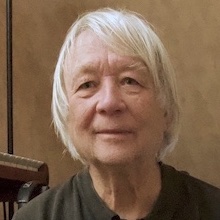ABSTRACT:
Concrete music consists of composing extraordinary sounds from recorded sounds.
By ear and thanks to digital audio and electroacoustic devices, everyday sounds reveal textures and contours that astonish those who pay attention to them. Thus an unexpected sound universe and a whole artistic potential opens up to the imagination of musicians and listeners.
Through examples of sound experimentation, this page proposes a path to discover the creative work of sound sculpture that is specific to this music. Without focusing on the technological tools of audio processing, the aim is rather to insist on the exercise of listening carefully to the sounds for themselves: the original sounds, then the sounds which have been worked on.
 AUTHOR: Charles-Edouard Platel, composer of electroacoustic music.
AUTHOR: Charles-Edouard Platel, composer of electroacoustic music.
- Introductory listening
- Presentation of the workshop
- Sound Sculpture
- An amazing exploration
- Sound Transmutations
- Final Listening
1. Introductory listening (10 mn)
![]() Excerpt of the work "Very far very close"
Excerpt of the work "Very far very close"
Here are a few questions proposed following this listening:
- open question: what words come to mind to describe this music?
- have you identified one or more instruments / instrumentalists?
- did you hear a melody?
- did you notice any rhythm, wave or vibration?
2. Presentation of the workshop (10 mn)
Electroacoustic listening
Live music brings musicians and their listeners together at the same time and in the same place. Musicians play their voices and instruments, producing rhythms and melodies. The listeners participate in the event by listening and supporting.
Musicians who have performed on stage or in the studio may have been recorded on a given date. This allows the listeners to listen to the music from a turntable, radio or computer application, thanks to an electro-acoustic system that transmits the sound through speakers (or headphones),
We have just heard sounds produced by electroacoustic machinery: loudspeakers (or headphones), activated by digital audio converters that translate computer audio files. In your opinion:
- Can we also talk about "musical practice" in this situation?
- Can we use this electroacoustic system for any purpose other than listening to recordings of musicians who have performed on stage or in the studio on a given date?
- What other uses can then be imagined?
Let's react to some sound recordings from the real world
A - ![]() Continuum of background noise, coming from nature or human activity
Continuum of background noise, coming from nature or human activity
- do you think that these 3 sound clips are authentic or acoustically modified?
- do you think that the way they are mixed together in this recording makes sense (intentional or accidental)?
- (same questions).
3. Sound Sculpture (10 mn)
Presentation of some processes: spectral transposition, slowing down/accelerating, inversion, cuts,
A - Back to the introductory music: the sounds come from the shaping of the sound material found in the resonances of a Tibetan bowl.
![]() original Tibetan bowl, then,
original Tibetan bowl, then, ![]() transpositions and slowdown
transpositions and slowdown
what has changed in the perception of the listener?
B - Other examples of work on the sound sample:
--> ![]() original sound, inversion, palindrome looping
original sound, inversion, palindrome looping
--> ![]() original sound, slower and slower and lower
original sound, slower and slower and lower
--> ![]() circular scraping, then slowed down and transposed
circular scraping, then slowed down and transposed
4. An amazing exploration (10 mn)
A story of an unexpected acoustic encounter, which later became a musical piece:
--> ![]() walking down the street, microphone in hand
walking down the street, microphone in hand
--> then in studio, ![]() work on birdsong
work on birdsong
--> also exploring ![]() another birdsong
another birdsong
--> this research led in 2011 to the composition of a ![]() part of the musical work "Anachronistic poems"
part of the musical work "Anachronistic poems"
5. Sound Transmutations (5 mn)
Finally, the sound objects of musique concrète no longer have the memory of their original material. The composer can then use them in the same way as he uses synthetic or instrumental sounds. However, the originality of the approach of musique concrète lies in the unpredictability, the joyful games of the randomness of the finds, the exploratory curiosity or the patient meditative attention. Here are a few more examples:
--> ![]() a brief sound, repeated, then slowed down and transposed to the low register
a brief sound, repeated, then slowed down and transposed to the low register
6. Final Listening (5 mn)
![]() Continuation of the work "Very far very close"
Continuation of the work "Very far very close"
For more information...
Some links related to this workshop:
- Introduction to musique concrète, by its "inventor" Pierre Schaeffer, 1948 text that can be read on the site of the composer Roland Cahen.site of the composer Roland Cahen.
- INA-GRM site, Groupe de Recherches Musicales: 60 years of sound creation and today concerts, broadcasts, portraits of composers, software...
- La Muse en circuit
- IRCAM, Institut de Recherche et Coordination Acoustique/Musique
On this site:
- Computer music, some notions... : introductory paper.
- Ondolon: sculptor for recorded sounds : technical paper presenting the application used to achieve the above examples.
The timing indicated in this article is approximate.
